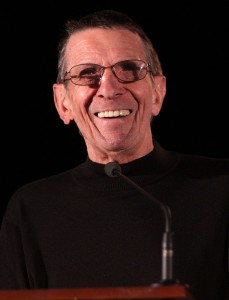Leonard Nimoy Leaves the Legacy to “Live Long and Prosper”
March 12, 2015Leonard Nimoy, an actor who was most well-known for playing Mr. Spock, the half-Vulcan and highly logical crew member in the Star Trek franchise, taught the world what it meant to be human by playing an alien. He left the world an iconic character that struggled with the foibles of humanity, including friendship, the quest for knowledge, war and conflict and the desire to rise above.
Nimoy died at his home in Los Angeles February 27 at age 83 after being hospitalized earlier in the week. Nimoy’s wife, Susan Bay Nimoy,  confirmed the cause of death as end-stage chronic obstructive pulmonary disease (COPD). Last year, Nimoy had announced that he had COPD and attributed the disease to prior years of smoking, even though he had quite smoking three decades ago.
confirmed the cause of death as end-stage chronic obstructive pulmonary disease (COPD). Last year, Nimoy had announced that he had COPD and attributed the disease to prior years of smoking, even though he had quite smoking three decades ago.
Social Impact
Nimoy considered his work not just a job, but an opportunity to have an impact on society. In a 2009 interview with The Associated Press, Nimoy said, “I’ve fulfilled that dream, including ‘Star Trek,’ for that matter. If that’s part of the legacy, then I’m very pleased with that. I would hope the work I chose to do had some reason for being done other than just simply being a job.”
Nimoy’s fans would agree that he met his goal. Scientist77 left this comment on the Fox News website: May God bless Leonard, he made our lives better. Thank you Mr. Spock, we will really miss you.
Another fan commented on the same website: He “Lived long” and We “Prospered”
Active on social media, Nimoy’s final twitter on Feb. 23 was both prescient and poignant: A life is like a garden. Perfect moments can be had, but not preserved, except in memory. LLAP [abbreviation for “Live Long and Prosper,” Nimoy’ signature line as Mr. Spock’s Vulcan greeting].
Astronaut Terry W. Virts, a NASA astronaut on board the International Space Station, tweeted a photo of the Vulcan hand salute with Boston, Massachusetts, Nimoy’s hometown, seen through the window of the space station. Italian astronaut Samantha Cristoforetti, also aboard the International Space Station, joined the tribute and tweeted, “Live Long and Prosper, Mr. Spock!”
Nimoy drew upon his Jewish heritage in developing the signature Vulcan hand salute. Nimoy based the gesture on the split-fingered hand sign used by rabbis during the priestly blessing. The position of the fingers represents the Hebrew letter “shin” for Shaddai, one of the Hebrew names for God. In an interview for the Wexler Oral History Project at the Yiddish Book Center, located on the edge of the Hampshire College campus in Amherst, Massachusetts, Nimoy said the hand signal took off right away. Within days of the first Star Trek episode to utilize the Vulcan greeting, fans were greeting Nimoy on the street with the hand sign and it continued for the rest of his life and now beyond his life.
Although he had legions of fans due to his portrayal of Mr. Spock, Nimoy was also an accomplished director, stage actor, photographer, musician and writer. Nimoy published numerous collections of his poems, including “A Lifetime of Love: Poems on the Passages of Life” in 2002; two autobiographies; and a book of his photographs devoted to the Jewish idea of the female aspect of God called “Shekhina.”
Early Life
The actor was born in the West End of Boston on March 26, 1931, as Leonard Simon Nimoy, the second son of Yiddish-speaking Jewish immigrants from Iziaslav in the former Soviet Union, now Ukraine. His parents Max and Dora Nimoy left Iziaslav separately and reunited in the United States. Nimoy’s father left first and walked over the border into Poland before leaving Europe for America. Nimoy had an older brother, Melvin. His father, Max, owned a barbershop in Mattapan and his mother Dora was a homemaker.
Nimoy was bitten by the acting bug early in life and performed in local productions from the age of eight. He won several parts at a community college, where he performed through his high school years. In 1949, after taking a summer course at Boston College, he traveled to Hollywood, though it wasn’t until 1951 that he landed small parts in two movies.
Nimoy continued to find bit parts until he landed his first starring movie role in 1952 in “Kid Monk Baroni,” in which he played a disfigured Italian street-gang leader who becomes a boxer.
Nimoy served in the Army for two years, and spent eighteen months at Fort McPherson in Georgia, where he participated in shows for the Army’s Special Services branch. He also directed and starred as Stanley in the Atlanta Theater Guild’s production of “A Streetcar Named Desire” before being discharged in the rank of sergeant November 1955.
Nimoy returned to California, where he worked odd jobs while studying acting at the Pasadena Playhouse. He landed several TV roles in the late 1950s and early 1960s on shows such as “Wagon Train,” “Rawhide” and “Perry Mason.” Then came “Star Trek” and the rest is history.
Leave a Comment